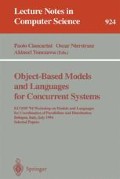Abstract
The coordination among a set of concurrent objects is commonly expressed through language specific synchronization mechanisms in the objects implementation. Unfortunately, such an approach makes it difficult to reuse these objects in applications with different coordination patterns. Moreover, the algorithms used for object coordination are inextricably linked to the original object implementation and cannot themselves be easily reused for the coordination of objects with different implementations. In this paper, we propose a model that promotes the reuse of both objects and coordination patterns. The model allows objects to synchronize their execution with events occurring in other objects (e.g. state changes and method invocations) in a way that is compatible with local object synchronization constraints and respects encapsulation. The model also supports the use of class inheritance while avoiding most of the problems of combining inheritance with synchronization. Finally, we consider the use of the model in the area of distributed multimedia applications. In this area active objects encapsulate media processing activities while a synchronous language is used to specify their temporal coordination.
Preview
Unable to display preview. Download preview PDF.
References
M. Aksit, K. Wakita, J. Bosch, L. Bergmans and A. Yonezawa, ”Abstracting Object Interactions Using Composition Filters,” in Object-Based Distributed Programming, LNCS 791, Springer-Verlag, 1993.
L. Bergmans, “Composing Concurrent Objects,” Ph.D. Thesis, University of Twente, 1994
G. Berry and G. Gonthier, “The ESTEREL Synchronous Programming Language: Design, Semantics and Implementation,” 842, INRIA, 1988.
G. Berry and I. Cosserat, “The ESTEREL Synchronous Programming Language and its Mathematical Semantics,” LNCS, vol. 197, Springer Verlag, 1985.
G. S. Blair, M. Papathomas, G. Coulson, P. Robin, J.B. Stefani, F. Horn and L. Hazard, “Supporting Real-time Multimedia Behaviour in Open Distributed Systems: An Approach Based on Synchronous Languages,” Proc. of ACM, Multimedia'94, 1994.
F. Boulanger, “Integration des Modules Synchrones dans la Programmation par Objects,” Thèse no.2977. Ecole Supérieure d'Eléctricite, Université de Paris-Sud, Centre d'Orsay.
P. Caspi, D. Pilaud, N. Halbwachs and J. Plaice, “LUSTRE, a Declarative Language for Real-Time Programming,” Proceedings POPL'87, ACM, Munich.
E Coste-Maniere, “Utilisation d'Esterel dans un contexte asynchrone: une application robotique,” Research report 1139, INRIA, Dec. 1989, (in French).
G. Coulson, G. S. Blair, P. Robin and D. Shepherd, “Extending the Chorus Micro-Kernel to Support Continuous Media Applications,” Proc. of the 4th International workshop on Network and Operating Systems Support for Digital Audio and Video, Nov. 1993, Lancaster, UK.
S. FrØlund and G. Agha, “A Language Framework for Multi-Object Coordination,” Proceedings ECOOP'93, LNCS vol. 707, July 1993, pp. 346–360.
D. Harel and A. Pnueli, “On the Development of Reactive Systems,” Logics and Models of Concurrent Systems, K. Apt (Ed.), NATO ASI series, Springer, 1985.
D. G. Kafura and K. H. Lee, “Inheritance in Actor Based Concurrent Object-Oriented Languages,” Proceedings of the Third European Conference on Object-Oriented programming Languages, S. Cook (Ed.), British Computer Society Workshop Series, CAMBRIDGE UNIVERSITY PRESS, 1989.
P. Le Guernic, A. Benveniste, P. Bournai and T. Gauthier, “SIGNAL: a Data Flow Oriented Language for Signal Processing,” Report 246, IRISA, Irisa, Rennes, France, 1985.
S. Matsuoka, K. Taura and A. Yonezawa, “Highly Efficient and Encapsulated Re-use of Synchronization Code in Concurrent Object-Oriented Languages,” Proc. OOPSLA '93, ACM, SIGPLAN Notices, vol. 28, no. 10, pp. 109–129, October 1993.
B. Meyer, “Systematic Concurrent Object-Oriented Programming”, Communications of the ACM, vol. 36, no. 9, September 1993.
Author information
Authors and Affiliations
Editor information
Rights and permissions
Copyright information
© 1995 Springer-Verlag Berlin Heidelberg
About this paper
Cite this paper
Papathomas, M., Blair, G.S., Coulson, G. (1995). A model for active object coordination and its use for distributed multimedia applications. In: Ciancarini, P., Nierstrasz, O., Yonezawa, A. (eds) Object-Based Models and Languages for Concurrent Systems. ECOOP 1994. Lecture Notes in Computer Science, vol 924. Springer, Berlin, Heidelberg. https://doi.org/10.1007/3-540-59450-7_10
Download citation
DOI: https://doi.org/10.1007/3-540-59450-7_10
Published:
Publisher Name: Springer, Berlin, Heidelberg
Print ISBN: 978-3-540-59450-5
Online ISBN: 978-3-540-49269-6
eBook Packages: Springer Book Archive

